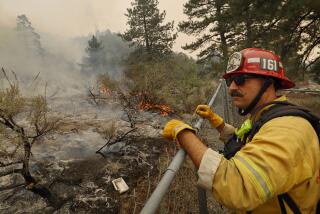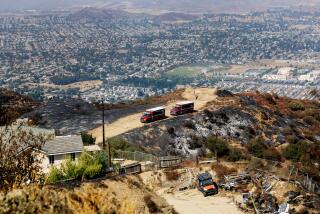Firefighters Possess the Touch in Midas
- Share via
MIDAS, Nev. — About 1,000 firefighters from all over the country--from Alaska to Mississippi, from Pasadena to San Bernardino--drove along 30 miles of unpaved roads to reach this little mining hamlet, populated by 23 people and shrouded in smoke. On Thursday, they saved it.
At first, the firefighters weren’t sure what there was to save, as they traveled through parched range land and alongside the treeless Snowstorm Mountains and over creeks that barely trickled with water.
This wasn’t at all like the tall timber fires of the Pacific Northwest, where flames leap across the crowns of trees and shoot fire 100 feet into the air. Here they saw fire sweeping across a desert floor that from a distance didn’t even appear flammable.
The firefighters here, and their peers across the region, continued to battle both kinds of fires Thursday. A dozen big fires were contained, fire officials in Boise, Idaho, said, even as eight new ones were getting their attention. The scorecard: 42 active fires in 10 Western states that have so far consumed more than half a million acres.
In barren Midas, it took the visiting crews a day or so to understand the value of this high desert country not far from the Idaho border. They couldn’t spot the bighorn sheep and the deer along the mountain slopes and didn’t fully realize how the range land was a pantry of feed for beef cattle. They didn’t grasp how the sagebrush provided a canopy of shade to cool the creeks where the threatened Lahntan cutthroat trout run.
And those power lines? They delivered electricity to the most productive gold mines in the country. But they learned these realities from the local folks and redoubled their efforts to extinguish a pair of fires ignited by lightning Sunday that were making their way toward Midas.
Each blaze was growing by the minute, spreading faster than a person could run, and each heading toward the homes from different directions. Morning winds blew one fire from the south; afternoon winds drove a second fire from the north.
Midas stood in the middle of the closing vice, and the folks who live here were told to get ready to evacuate. Three alternative dirt roads were selected for escape, depending on how the winds would be blowing at the moment of evacuation. Most said they wouldn’t leave. They would either gather in the grass playground of the 65-year-old former schoolhouse or within the tunnels of old mines that had long given up the last of their gold.
But the firefighters dug in with their shovels and pickaxes and bulldozers and water-dropping helicopters and retardant-spewing airplanes, and the weather cooperated too, and by Thursday, Midas had been rescued.
Then they started talking about heading to the next fire, maybe 1,000 miles away, to save another town, maybe nestled in the tall trees of an Oregon forest or in the dry deserts of eastern Washington.
The Midas victory is how the battle is going these days across the West: determined stands by firefighters to save scattered ranches and vacation cabins, slowly but surely taking control over some of the biggest fires peppering the region.
Thursday was a pretty good day, said the wild land fire experts at the National Interagency Coordination Center in Boise. “Overall, we’re making pretty good progress,” said spokeswoman Sue Tholen.
Crunch time would come today and this weekend, she said, as a weather front moves through the Pacific Northwest. The forecast called for widely scattered but dry thunderstorms, bringing more wicked winds and lightning, the deadly combination that has set hundreds of thousands of acres of Western land ablaze over the last week.
The storms were expected to pass by Monday, Tholen said. At that point, the forecast was for temperatures to drop as much as 15 degrees from the high 90s and hotter, bringing long-sought relief to firefighters who have been going nonstop.
In spite of that forecast, the Northwest Interagency Coordination Center has requested firefighting reinforcements from the military, a tactic that is now possible after Thursday’s declaration that the fires had reached their highest state of urgency.
One battalion of Marines from Camp Lejeune, N.C., and another of Army troops from Ft. Lewis, Wash., are being deployed to help fight the Northwest wildfires, said George Lennon, another spokesman at the coordination center.
A battalion has between 400 and 600 soldiers.
No homes had been lost to flames in the last two days, she said.
The biggest and most volatile fire in California was burning in the Modoc National Forest, near the Oregon and Nevada borders. It had charred 33,000 acres, and 40% of the fire has been successfully encircled by firefighters.
A fire south of Medford, Ore., had burned through 5,500 acres of tall timber. Even though 1,200 firefighters were assigned to the blaze, they still had not built firebreaks around it.
“A fire in the desert can run hot and fast, but as soon as you can get a line around it, you can start to knock it down,” Tholen said. “But timber fires burn in steeper terrain and can spread along the tops of trees, and they create firestorms that can send flying embers a mile ahead.”
The largest fire was burning near Lakeview in eastern Oregon. It had scorched 180,000 acres, was only 25% contained and was spreading at an extreme rate, Tholen said.
In north-central Washington, residents of the three small towns of Malott, Okanogan and Omak were told they might have to evacuate. The fire had grown to 43,000 acres and was 35% contained.
Near Leavenworth, Wash., a stubborn forest fire had grown to 1,400 acres. The blaze was throwing embers ahead of itself and igniting still more spot fires.
And not far from here, a 15,000-acre desert fire was still burning at will in the mountains around Winnemucca.
But here in Midas, residents were breathing easier Thursday afternoon. The 19,000-acre fire that came within half a mile of them was encircled by firebreaks and deemed no longer a threat.
And the 58,000-acre fire just south of them, which for a time threatened to blow right up their canyon of cottonwood and poplar trees, had changed directions and was burning south.
“We always get excited when we see smoke, and when we saw it Sunday, and then smelled it, it was a little spooky,” said Don Mellen, who with his wife runs the Gold Circle Bar.
The saloon’s rafters are literally plastered with nearly 1,000 one-dollar bills, signed by customers who have quaffed beers here.
“We had cowboys coming in here after moving their cows off the ranges,” he said. “They were dusty and smoky and they really wanted their beers.”
On Thursday, they sang the firefighters’ praises. “They’ve been putting their lives at risk for us and our property, and we can’t say enough about them,” said LaVerne Mellen. The firefighters spoke fondly too of the people of Midas.
“I like this little town. This is the kind of hardscrabble little place you read about, and you admire the people who live here,” said Jim Wilkins, part of the Southern California fire command team that was sent to oversee the firefight. “They’ve been putting fires out around here for years with little outside help. But sometimes a fire gets even too big for them.”
Wilkins and his team members from the San Bernardino County, Los Angeles County and Pasadena fire departments were dispatched a week ago when the Nevada Division of Forestry asked for help, anticipating last weekend’s lightning storms and the ensuing fires.
“The Nevada folks were ahead of the curve in anticipating what would happen,” Wilkins said. “And we had some quick learning to do. We don’t see range land fires like this in Southern California.
“They told us their range land was more important than their houses. We heard people say they could rebuild their houses but a burned range wouldn’t come back for years. So we made that a priority. These people really appreciate their land.”
More to Read
Sign up for Essential California
The most important California stories and recommendations in your inbox every morning.
You may occasionally receive promotional content from the Los Angeles Times.













